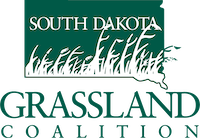Our mission is to improve stewardship of grasslands through sustainable and profitable management.
Our Goals
Promote ranching practices that are sustainable and increase profitability
Our members understand that grass is their crop and that livestock are the way they harvest it. Management that promotes healthy grasslands increases livestock gain and soil health. Diverse native grassland communities help reduce the effects of drought, and often require fewer inputs of insecticides and herbicides by keeping the ecological system intact. A healthy functioning ecosystem balances the void that often occurs when managers treat symptoms instead of the cause of problems like weeds or low production.
At a time of high land prices, rather than trying to buy more land, think about how you can increase the efficiency and profitability of the acres you already own.
Enhance water quality and reduce runoff into our streams and lakes
Healthy grasslands have diverse native grasses and forbs as well as healthy living soil that when put together create spectacular avenues for infiltration. Increased infiltration means less runoff that contributes to flooding and pollution. What little water does run off a healthy pasture is essentially free of nitrogen, phosphorous, suspended solids like soil particles, and harmful chemicals.
Conserving grasslands and managing them for diversity and soil health is one of the most effective ways to improve water quality and reducing flooding in South Dakota.
Increase the abundance of wildlife
Healthy native grasslands are perhaps the most important wildlife habitat in South Dakota. Unfortunately, in South Dakota we are losing up to 100,000 acres of grassland per year to row crop production and urban sprawl. The native tall grass prairie of North America is one of the most imperiled ecosystems in the world. Grassland birds are declining faster than any other group of birds on our continent. Healthy grasslands are vital habitat for waterfowl and upland game birds like pheasants, which have a huge impact on South Dakota’s economy.
Abundant wildlife and South Dakota are synonymous to many people. Healthy and diverse grasslands are the key to conserving this abundance.
Preserve our small towns and the ranching economy
Small towns and rural communities all over the Midwest have declined rapidly over the last 50 years. In South Dakota 60 out of our 66 counties declined in population between the 2000 and 2010 census. Ranches and farms with diversified systems and enterprises are the only way that the next generation of ranch and farm families are going to be able to stay on the land. An operation that includes multiple enterprises allows for multiple managers and abilities to support multiple families. Gone are the days where “the farm” or “the ranch” is going to support mom, dad, son, and/or daughter. It has to become a business offering multiple functions on the same piece of land rather than the same function on more land, because the availability of those extra acres is becoming harder and harder to come by. Diversified operations with multiple enterprises allows for the business to draw profits from different areas and thus makes the business model much more stable. It also ups our profits per acre of land operated. Doing more with what we have rather than needing more to do more. Evaluating every acre and using it in the best possible way is key. For the SDGC we believe that means to get more grass on the ground in areas that more suited for grass than row crops. Then, operators must manage that grass in a way that increases diversity of plants, ability to graze cattle, healthy watersheds, and a functioning ecosystem for wildlife. This is critical because to paraphrase Franklin Roosevelt, ‘the country that destroys its land destroys itself.
Diversifying land use and making land use more profitable while increasing the health of the ecosystem is the best way to preserve our rural communities.
Achieving our Mission and Goals
Three principles underlie the Coalition’s mission and goals:
Grassland is not just Grass
The Coalition believes that good grassland management is based on recognizing that the term “grassland” is actually shorthand for grasses and other plants, the soil these plants grow in, the animals that live in and feed upon the plants and each other, and the physical and chemical processes that transform sunlight into energy that humans can use. Each of these elements is critical in sustaining the grassland ecosystem and the profitability of livestock production.
Education
The Coalition does not promote enforced compliance of any land use practices on private land. Instead, we believe that information and education about the economic benefits of proven grassland and livestock management practices are incentives for land owners to adopt these practices for their own benefit and the benefit of their children and grandchildren.
The coalition focuses on presenting workshops, field tours and nationally and internationally-known speakers tailored to the information needs of producers. By presenting actual case studies from South Dakota and surrounding states, and the best scientific information, producers learn how their economic bottom line will improve by improving the health of their grassland.
Because the Coalition recognizes that no two landowners’ operations and challenges are the same, a variety of techniques to improve grassland health are presented.
Voluntary Participation by Landowners is Critical to Reaching the Nation’s Conservation Goals
States like South Dakota and the rest of the Northern Great Plains are priorities for wildlife conservation, water quality, carbon sequestration and other national conservation goals. Traditional approaches by conservation agencies have been based on paying landowners to do things that benefit the environment we all share. It will never be feasible to pay enough landowners to adopt ecologically friendly practices to achieve our national goals in perpetuity.
The Coalition believes that success lies in producers recognizing that it is in their own best interest to adopt the management practices that increase the sustainability and long-term profitability of their operations. Conserving grassland is key to the nations conservation goals.
Sustainable and profitable livestock production pays for the conservation of grassland!
